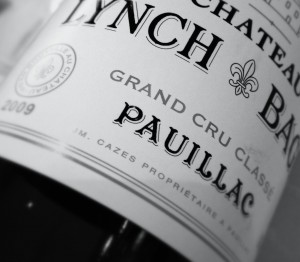Jean-Charles Cazes of the Cazes family (owner of Ch. Lynch-Bages since the 1930s) was in town co-hosting a number of wine dinner and charity events. The famous Pauillac 5th growth needs no introduction. In recent years, its following has not only steadily grown in the wine drinking world at large, its consumption and brand value has enjoyed exponential surge in the now massive Oriental market. It is now one of the most well-regarded and recognised old world wine names in the region.
The fact that the 09′ Lynch-Bages is powerful, well-balanced, lusciously concentrated with big elegant tannins and a long finish is well publicised. These characteristics are by no means unique among the 09′ Bordeaux offerings. 2009 is truly a great Bordeaux vintage. Wine writers have been searching high and low for superlatives after superlatives to communicate with their readers the phenomenal quality that this vintage confers. To me, however, the real value of 09′ Lynch-Bages lies elsewhere.
When presented with the list of wines to be served in this wine dinner at the Dynasty Club (Hong Kong), I was surprised that the ’09 Lynch-Bages was shown at all. At the time of the dinner, the bottled product had not even reached the hands of its buyers. Even though Lynch-Bages has a reputation in recent years of producing wine that is drinkable early yet with great cellaring potential, consuming an ’09 is, for all intents and purposes, “infanticide”. Not only that, in obstetric terms, this is a premie, fresh from the Caesarean-section theatre on its way to the neonatal unit …… or so I thought.
The ’09 Lynch-Bages, decanted for a mere 2 hours, paired with a Wagyu beef cheek dish, is actually approachable, now. Don’t get me wrong, I am not advocating opening all the ’09 LB now. I most certainly am not saying that this wine is at its peak. In fact, I’m sure it will continue to evolve and improve over the next quarter of a century at least, if not longer. Nevertheless, it is still a pleasant surprise that the wine has the flexibility to be drunk now. This “flexibility” is potentially hugely attractive from a value standpoint. To find out how much value this represents, one needs to ask the question, “How much does wine storage cost you?”
Wine from exceptional vintages often requires a prolonged period of ageing. How much ageing is required or desired depends on the wine. Although, not every wine is a ’00 Margaux (1900 that is) or a ’61 (Latour), it is still common place to find wines from the ’82 vintage in the cellars of many wine drinkers.
Based on the spirit of responsible drinking, one still requires 30 years of rolling stock. Factor in good cellaring conditions, insurance premiums for one’s prized possessions, the cost quickly racks up. The most important cost consideration yet, is the location of the cellar. In a place like Hong Kong, where the lawnmower is the ultimate status symbol, a house with its own 30-year rolling stock cellar is still a rare commodity. With the average detached house price nearing US$30,000 per sq. metre, many professional wine storage facilities have sprung up to cater for the many apartment-dwelling wine consumers. From a few bottles to a few hundred cases, there are rental schemes suitable for all comers, at a price.
Considering all these, the now-approachable ’09 Lynch-Bages is a bargain when compared to other similarly rated Bordeaux of great vintages. Opponents of this view may argue that one’s wine purchasing choices should not be purely financially motivated. To them, I present the case of a certain politician in Hong Kong, odds on favourite candidate of high political office, whose prospect of getting elected was irreparably damaged by the exposé of his illegally constructed 2,000 sq. ft subterranean wine cellar. If only ’09 Lynch-Bages were his house wine …….. more tk.

